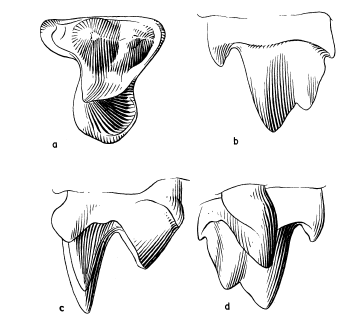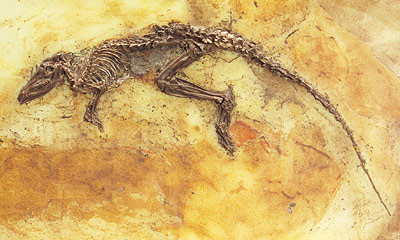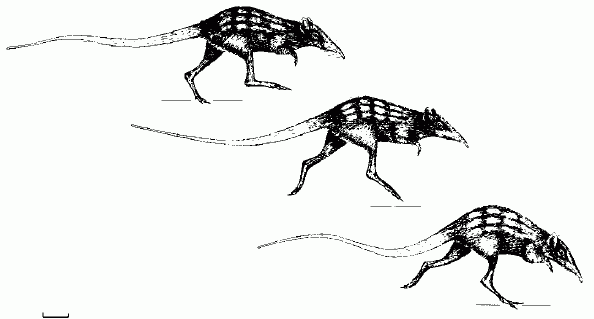| Eutheria | ||
| The Vertebrates | Leptictida |
| Vertebrates Home | Vertebrate | Vertebrate |
|
Abbreviated Dendrogram
Mammalia
├─Metatheria
└─Eutheria
└─┬─Eomaia
└─┬─Zhelestidae
└─┬─Asioryctitheria
└─┬─Zalambdalestidae
└─Apomorphic Placentalia (arbitraily placed here)
├─Leptictida
│ ├─Gypsonictops
│ └─┬─Leptictidae
│ └─Leptictidium
└─┬?─"Cimolesta"
└─Crown Group Placentalia
|
Contents
Overview |
Taxa on This Page

Leptictidium and young.
Image from Walking With Beasts © 2002 BBC, original url
Adapted from Wikipedia
The Leptictida ("small/slender weasel") are a very primitive order of eutharian, presumably placental, mammals. Current cladistic studies place them close to the base of crown group placentals Wible et al 2009, Goswami et al 2011. They are representative of the late Cretaceous-Paleocene evolutionary radiation that preceeded and existed alongside the early crown group placentals. Both waves of eutharian evolution benefited with the extinction of the non-avian dinosaurs, and indeed the Palaeocene and early Eocene may have been more dominated by stem group eutharians than crown group placentals. The leptictids themselves survived as long as the Oligocene, comparable in this respect to the Multituberculates, another Mesozoic group that flourished in the early Cenozoic. While most were shrew like in appearance. their best known representative is the extraordinaery, bipedal Leptictidium (hominines and kangaroos are the only other fully bipedal mamals), known from the middle Eocene lagerstatten at Messel, Germany. Standing a mere 20 cm tall, and about about 60-90 cm long including the tail, it would have dashed through the undergrowth like a long-tailed leprachaun. The long tail, a strong but short trunk region and relatively long hindlimbs and short forelimbs were indicative of a balancing animal. Benton 2005 p.337
Apomorphic Placentals (arbitraily placed here)
Range: Latest Cretaceous to Recent
Phylogeny: Eutheria ::: Adapisoriculidae + (Zhelestidae + (Asioryctitheria + Cimolestidae) + (Zalambdalestidae + * : Leptictida + Palaeoryctidae + Placentalia)).
placenta, long gestation, loss of epibubic bones;
Comments: we distinguish between stem Eutheria (people > possums), apomorphic Placentalia (mother nurtues developing fetus with placenta), and Crown Group Eutheria/Placentalia (LCA of all recent placentals, and all its descendents). In cladistics, an apomorphy is a trait unique to a particular taxon. An apomorphy-based clade is defined by its physiological or biological characteristics, rather than (as with stem- and node-based clades) its position on the evolutionary tree. Homoplasy (convergence), reversals (loss of original traits), and other such morphological changes make apomorphy-based clades unreliable, and few cladists rely on them now. Nevertheless, at some point certain characteristics do appear in the course of evolution, even if determinibg the exact moment and point on the evolutionary tree may be difficult or even impossible (for example, are diadectomorphs amphibians or reptiles? We have assumed they are amnphibians very close to reptilian ancestry, but they may be apomorphic (amniote egg-laying) reptiles, even if they are outside the crown group amniota. Similarily, in the course of mammal evolution, at some point female eutherian mammals developed a placenta to transmit nuitruients while alos protecting the embryo from the mother's immune system. Logically, it is at this point that the prepubic bone disappears to enable the mother to accommodate growing young. This gives us at leats some idea where placentals first appear on the phylogenetic tree. For example, Zalambdalestids, a group closely related to leptictids, retain epipubic bones (Novacek et al., 1997, Rose 2006 p.92), which shows that they cannot be crown group placentals, although they may still have had a rudimentary placenta (soft parts obviously are not fossilised) Baring coincidence, or major adaptive evolution driven by ecological opportunity (which may be quite likely, look at the Cambrain explosion), true placentals may have been around for some time prior to the end Cretaceous extinction event, but it is only after that time that they radiated into the vast diversity of placental mammals that characterise the Cenozoic era. MAK120713.
Range: Late Cretaceous to Late Oligocene
Phylogeny: Eutheria ::: Adapisoriculidae + (Zhelestidae + (Asioryctitheria + Cimolestidae) + (Zalambdalestidae + (Placentalia + * : Gypsonictops + (Leptictidae + Leptictidium)))).
Note: At one time a possible stem lineage of the Pholidota, now considered a stem eutherian close to the ancestry of Placentals
Links: Leptictida after McKenna & Bell, 1997; Nathis Fauna Insectivoren en creodonten (Dutch); MESOZOIC MAMMALS; 'basal' Epitheria, an internet directory.

Range: Campanian (Late Cretaceous) of North America. Also found in Belgium or the Uzbekistan .
Phylogeny: Leptictida : (Leptictidae + Leptictidium) + *
Comments: Described by George Gaylord Simpson in 1927, Gypsonictops is the only genus of the monotypal family Gypsonictopidae. As the earliest representatives of the Leptictida they would be ancestral to Cenozoic lepticids. Size varied according to species: the smaller specimens weighing about 21 grams and the largest 84 g, with an average weight of about 50 g. Like many other Late Cretaceous mammals, Gypsonictops had five premolars, while the vast majority of mammals have only four. On the other hand, five premolars are also a feature typical of more basal eutherian and more primitive mammals. One of the very few Cretaceous eutherians known from North America; at this time multituberculates and marsupials were the dominant mammals on this continent.
Image: Different views of a P4 tooth (premolar 4) of Gypsonictops. From George Gaylord Simpson 1951 American Cretaceous Insectivores, Public domain Wikipedia
Reference/link: Catalan Wikipedia MAK111210
Range: early Palaeocene to Late Oligocene of Europe, Asia and North America.
Phylogeny: Leptictida : Gypsonictops + (Leptictidium + * )
Comments: Many primitive characters: for example, they retain the jugal, a bone lost in true insectivores. postcranial characters show similarities to zalambdalestids Benton 2005 p.329. Leptictis, from the late Eocene to late Oligocene of North America, is the best known genus
Links: Wikipedia, Spanish Wikipedia MAK111210

Range: Eocene of Europe.
Phylogeny: Leptictida : Gypsonictops + (Leptictidae + * ).
Comments: Known from the middle Eocene lagerstatten at Messel, Germany. Formerly classed with leptictids but probably belonging to a related family Leptictidium was a tiny biped. The long tail would have been used for balance as would the short strong trunk. The head had a long and slender snout, probably featuring a short trunk which was probably used for scratching the undergrowth in search of insects and worms. The mouth's archaic dentition included two to three incisors, a canine, and V-shaped cheek-teeth - four premolars and three molars. Leptictidium was probably a facultative biped: it ran, walked or hopped on its hindlegs, but could have adopted a quadrupedal posture for slow walking or standing. The Messel specimens feature a surprisingly long tail, unique among modern placental mammals, comsisting of forty vertebrae and probably used for balance. In this regard, they were convergent with small non-avian theropods (Benton 2005 p.337). MAK111210

Image:Top right: Fossil of Leptictidium tobieni at the Hessisches Landesmuseum Darmstadt via Wikipedia, copyright. Bottom left: Leptictidium, restoration of its running style. (Benton 2005 p.337, after Storch and Lister, 1985.), copyright Blackwell Publishing
Links: Wikipedia, NCRV - Leptictidium;
Page MAK111210; Links checked ATW051011